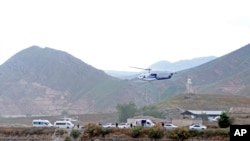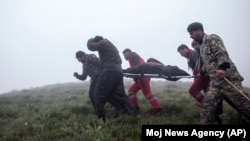Ten days after Iran’s president died in a helicopter crash in the country’s north, Iranian authorities have not explained why his was the only helicopter that crashed in dense cloud cover out of three that had been flying officials back to Iran from a visit to the Azerbaijani border.
Another unresolved question is how one of the passengers on the ill-fated helicopter apparently survived the May 19 crash in Iran’s East Azerbaijan province for several hours and answered several phone calls, according to Iranian state media, before rescuers reached the site and found him dead.
The passenger was identified as Iranian cleric Mohammad Ali Ale-Hashem, the East Azerbaijan representative of Supreme Leader Ayatollah Ali Khamenei. There were no survivors among the helicopter’s eight passengers and crew, including President Ebrahim Raisi and Foreign Minister Hossein Amir-Abdollahian.
The Iranian government’s latest assessment of the crash, shared in a TV report broadcast Sunday on state-run channel Network One, said the Armed Forces General Staff was “still investigating the cause of the accident.”
The report repeated an assessment shared by state TV several days earlier. It stated that the pilot of Raisi’s helicopter had instructed the other pilots to increase their altitude to emerge from the cloud cover. He apparently lost contact with the other helicopters 30 seconds later. The report said those aircraft made emergency landings at the Sungun copper mine 20 minutes after that, at 2 p.m. local time.
One significant new detail in the Network One TV report is that after the two helicopters landed, an official from one of those helicopters, Iranian Energy Minister Ali Akbar Mehrabian, spoke by phone to Ale-Hashem in the first few hours after the crash of Raisi’s aircraft. The report contained a brief clip of Mehrabian holding a phone and asking the cleric if he was OK.
Earlier, a second official who had been on one of the other helicopters, Raisi’s chief of staff Gholamhossein Esmaili, had told state TV on May 22 that after landing he also had spoken to Ale-Hashem by phone and heard that the cleric was hurt.
Farzin Nadimi, a Washington Institute for Near East Policy senior fellow specializing in Iranian security affairs, shared his assessment of some of the main unresolved questions from the Raisi helicopter crash in Wednesday’s edition of VOA’s Flashpoint Global Crises program.
The following interview transcript has been edited for clarity and brevity.
VOA: Why do you think two of the helicopters in Raisi’s convoy succeeded in rising above the cloud cover while his aircraft did not?
Farzin Nadimi, The Washington Institute for Near East Policy: Of the three helicopters in the convoy, the one in the front was a (Canadian-built) Bell 212, and the middle one carrying the VIPs also was a Bell 212. The third helicopter in the rear was a (Russian-built) MIL Mi-171.
The lead helicopter was equipped with a weather radar. The middle one with the VIPs was not, but apparently its pilot was in command of the convoy. There is no evidence that the pilot of the radar-equipped lead helicopter, who usually has a pathfinding role in bad weather, was in contact with the other helicopters. We do not have access to any recording of the pilots' communications. But the lead pilot should have warned the rear helicopters that they were encountering some bad conditions and low cloud cover.
Why the middle helicopter could not manage to increase altitude in time to clear the mountainous terrain, we do not know. For some reason, that pilot was not able to increase altitude quickly enough. Some technical malfunction might have contributed to this failure, or he may have calculated the barometric pressure incorrectly and thought he was able to clear the terrain.
VOA: Another curious aspect of the crash is the apparent initial survival of the cleric, Ale-Hashem, and his reported phone calls with several officials in the first few hours after impact. How could that have been possible?
Nadimi: It is a strange turn of events. The pilot of Raisi’s helicopter seems to have made a “controlled flight into terrain” [an aviation term meaning the aircraft accidentally hit the ground while under the pilot’s control].
While other clues may be found later and point us in a different direction, for now we believe the pilot flew into the terrain due to a mistake or technical issue. The aircraft’s attitude [an aviation term meaning its orientation relative to Earth's horizon] at the point of impact suggests that it crashed with heavy force. Some of the crew members and passengers were badly burned. However, in the initial stages of the crash, the force of impact probably threw this individual out of the cabin. For some reason, he miraculously survived the fall, and despite being badly injured, he had access to the pilot’s mobile phone.
VOA: That seems odd, doesn’t it?
Nadimi: It does seem odd, given the fact that the pilot and copilot would have been sitting in the front of the helicopter and would have absorbed the main force of impact. Their bodies seemed to have burned beyond recognition, but somehow, the pilot’s phone survived this impact and ended up close enough to this individual for him to answer the phone calls. That might be what actually happened. But such circumstances would be very strange.



